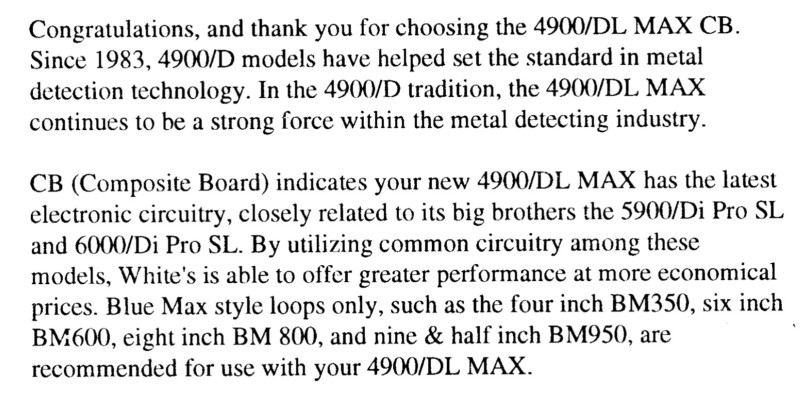-
Posts
20,046 -
Joined
Content Type
Forums
Detector Prospector Home
Detector Database
Downloads
Everything posted by Steve Herschbach
-

My New GPX 6000 Is Faulty, Straight Out Of The Box
Steve Herschbach replied to phrunt's topic in Minelab Metal Detectors
I’m absolutely in that camp with you Jason. I did not mention Simon assured me the weight etc of the GPZ was totally not a problem for him. But for me that 6K light weight, instant compact setup, etc. is exactly what I wanted, to the point where what I see as minor performance quibbles one way or the other are completely immaterial. I like the 6000, am satisfied with its performance, that’s what I’m going to use, end of story. -

Relic Hunting With The Minelab GPX 6000
Steve Herschbach replied to abenson's topic in Metal Detecting For Coins & Relics
Thanks for posting Andy. If anyone wants to go even further down the GBPI rabbit hole, a lot of technical information can be gleaned from the following thread and included links. The methodology works for any ground balancing PI (GBPI) detector. Minelab SD/GP/GPX/GPZ, Garrett Infinium/ATX, White’s TDI, and Fisher Impulse AQ, the launching point for the thread. -

6000 Vs 7000: Hot Rocks And Small Gold
Steve Herschbach replied to Gold Catcher's topic in Minelab Metal Detectors
In a nutshell, with stock coils, the two models respond to the same class of targets, but the GPX 11” mono is “hotter” than the GPZ 14 Super D coil. So the 6K hits smaller gold harder, and hits the same hot rocks the 7000 will hit, but also a little harder than the 7000. One exception is salt ground. While the 6000 does react strongly to it, GeoSense allows the 6000 to better control salt effects that really trouble the 7000. And yeah, both are great detectors, though in my case I only need one. -

Why I Tend Not To Post My Finds
Steve Herschbach replied to ☠ Cipher's topic in Metal Detecting For Coins & Relics
Never had a problem posting finds on multiple forums on the internet for over 20 years. -

My New GPX 6000 Is Faulty, Straight Out Of The Box
Steve Herschbach replied to phrunt's topic in Minelab Metal Detectors
I told you Simon, that there was no point in you buying a GPX 6000, if you were using a GPZ 7000 with a full complement of X Coils. If you are disappointed, you only have yourself to blame. Ergonomics aside, most people in small gold locations like the U.S. and New Zealand would probably prefer 6000 over GPZ. The 6000 11” mono generally works better on our gold than the GPZ 14” coil. But X Coils make up for that difference if used on the GPZ, negating the 6Ks main advantage. Again, ergonomics aside… though I think ergonomics matters a lot. Personally if I had neither I’d get the 6000 and avoid getting the more expensive GPZ, and then having to go the X Coil route to make the Z do what my 6000 does out of box. In your case however, you are already a GPZ user fully outfitted with X Coils. We discussed it, I told you take a pass on the 6000, you got one anyway. That’s fine, but honestly you should not be surprised or disappointed, when what you are seeing is what I told you. -

My New GPX 6000 Is Faulty, Straight Out Of The Box
Steve Herschbach replied to phrunt's topic in Minelab Metal Detectors
Long experience in retail has taught me that customers could care less about company excuses for lack of quality control. Why should they? It’s one thing when a person buys cheap stuff. You get what you pay for... or at least that’s the story. When you are buying the most expensive stuff made, you expect better quality. I have zero sympathy for Minelab on this one, and am sorry for anyone out there who has received less then they have deserved when buying a GPX 6000. It’s a genuine shame as it’s a great detector, but I surely understand the disappointment that results when a brand new, expensive purchase, fails to perform as expected. -

Gold Detecting On Bouldery Gravel Bars?
Steve Herschbach replied to troutsnouter's topic in Detector Prospector Forum
Depth on smaller nuggets is inches, multi ounce nuggets up to a couple feet. Detecting large gravel bars would generally be a waste of time. Go find bedrock. And check the history. No known gold production equals massive waste of time. You want history of larger gold for metal detecting. There is no such thing as an unprospected stream or river these days. VLFs do not do well on mixed composition materials, especially the Gold Bug 2. They do best where all the rocks and gravels are similar. The Gold Bug 2 in particular has a very narrow ground balance window, and anything outside the window is a hot rock. -
Minelab did exactly the same thing in the manual at the time of release. The frequency thing was literally beaten to death at the time on these forums. So for lots of us now that's an old subject, not some bright new thing XP came up with. The key is experimentation with settings on your own ground and your own targets, to learn what works best for you. Multi-IQ Explained Equinox - What Mode to Use and Where My own D2 just showed up.
-

Spearhead (red Sandstone) With Gold Inside?
Steve Herschbach replied to SHB111's topic in Rocks, Minerals, Gems & Geology
I don’t see anything that would make me think for two seconds there is gold in that spear point. Beyond normal microscopic background values that is. First rule of prospecting is learn what to look at, and what to simply ignore. The planet is full of stuff that looks like gold to people, but is not. I’m kind of amazed 5 pages has been spent on it. But hey, that’s what forums run on! -
Looks like an extremely common volcanic rock.
-

Thumb Scraper - Crystals?
Steve Herschbach replied to SHB111's topic in Rocks, Minerals, Gems & Geology
Looks like common quartz crystals, one of the most common crystals you can find. -
Good man Cipher. Monte’s post Not the same model, but according to the manual for 4900 DL Max: “CB (Composite Board) indicates your new 4900/DL MAX has the latest electronic circuitry, closely related to its big brothers the 5900/Di Pro and 6000/Di Pro SL” Knowing how companies spin things, I suspect this was nothing more than White’s moving to a different circuit board material than was used in previous models. They would take the simplest things, and try and make it sound like some big improvement, by creating a new acronym around it.
-
Ok, I was genuinely curious, that’s all. Lots of models I might know, but I’m unfamiliar with that particular variation. The designation CB is also not something I recall attached to any White’s models at all, but they did love their acronyms. Di=Discrimination SL=Slim Line. Pro= For Professionals, oh my! Hopefully somebody else will chime in.
-
Rechargeables read lower than alkalines, and NiCads suck in general. White's stuck with NiCad long after everyone else went to better batteries. Just ditch them, and use NiMH rechargeable AA batteries in your regular AA pack.
-
Great job Jeff, real detecting over "tests" any day of the week for me.
-

Ok Now What Do I Do? GPZ Lost Ferrite.
Steve Herschbach replied to Bigpicture's topic in Minelab Metal Detectors
Yeah, would not lose sleep over that if in U.S. due to large amounts of naturally occurring ferrite in most soils here.




